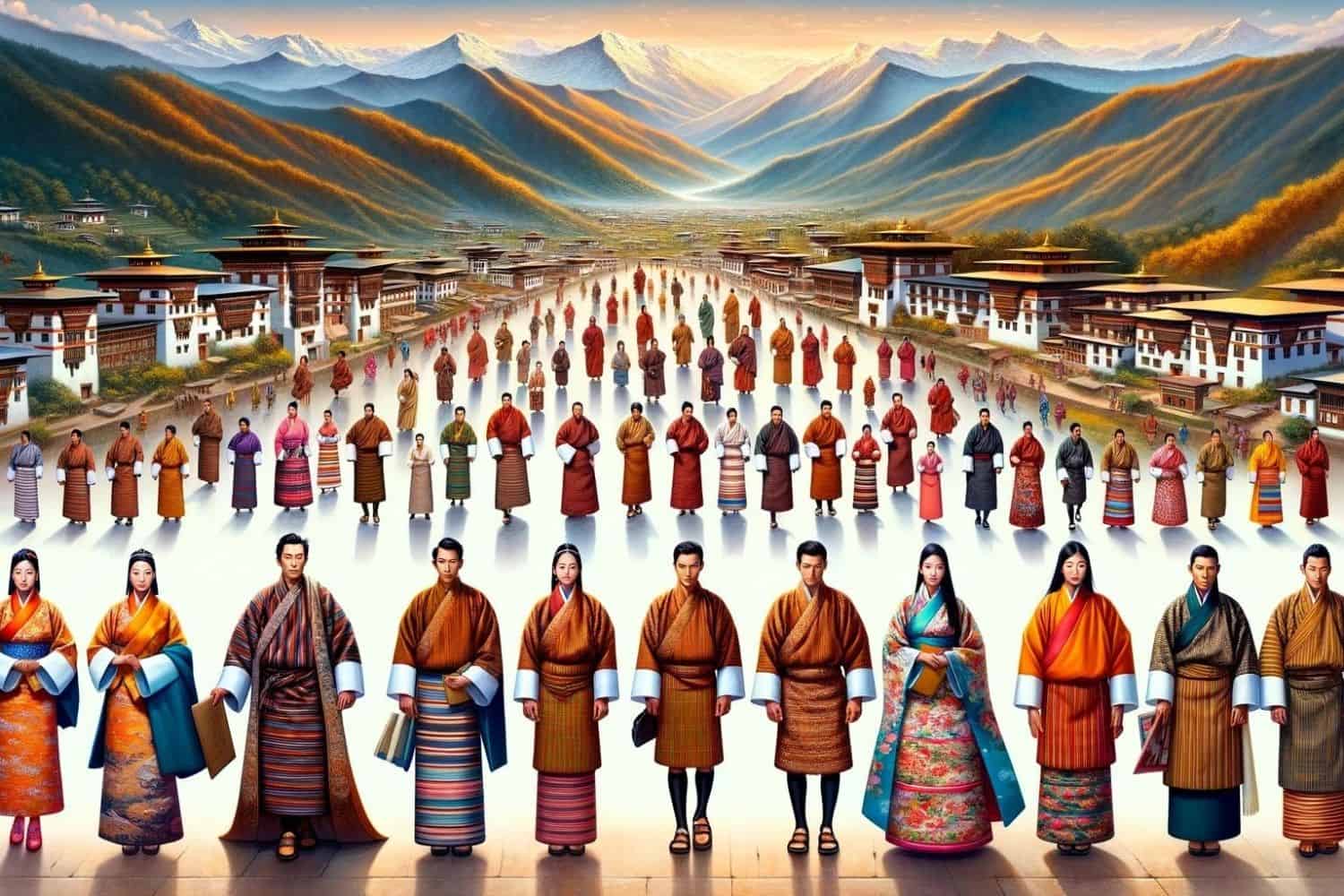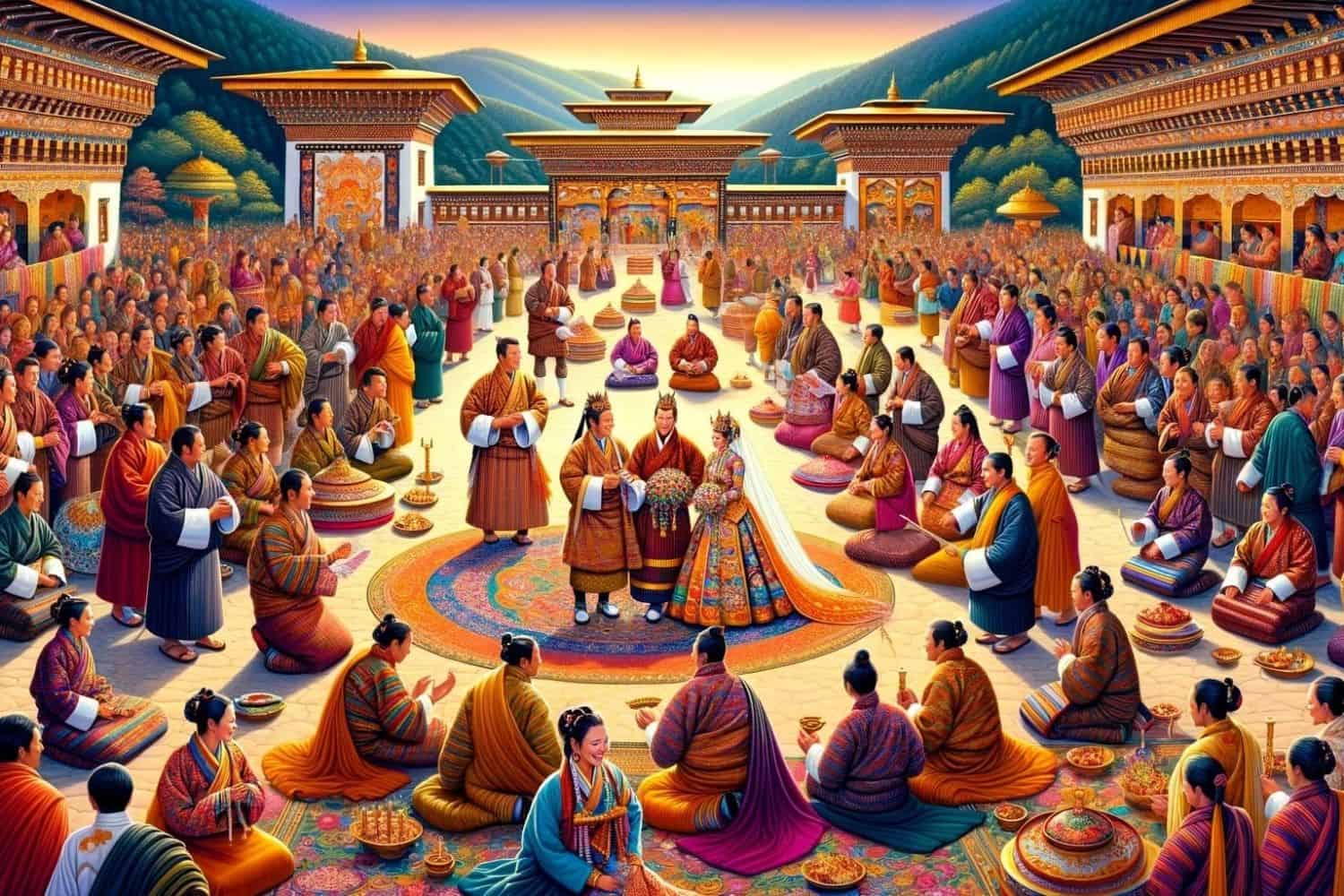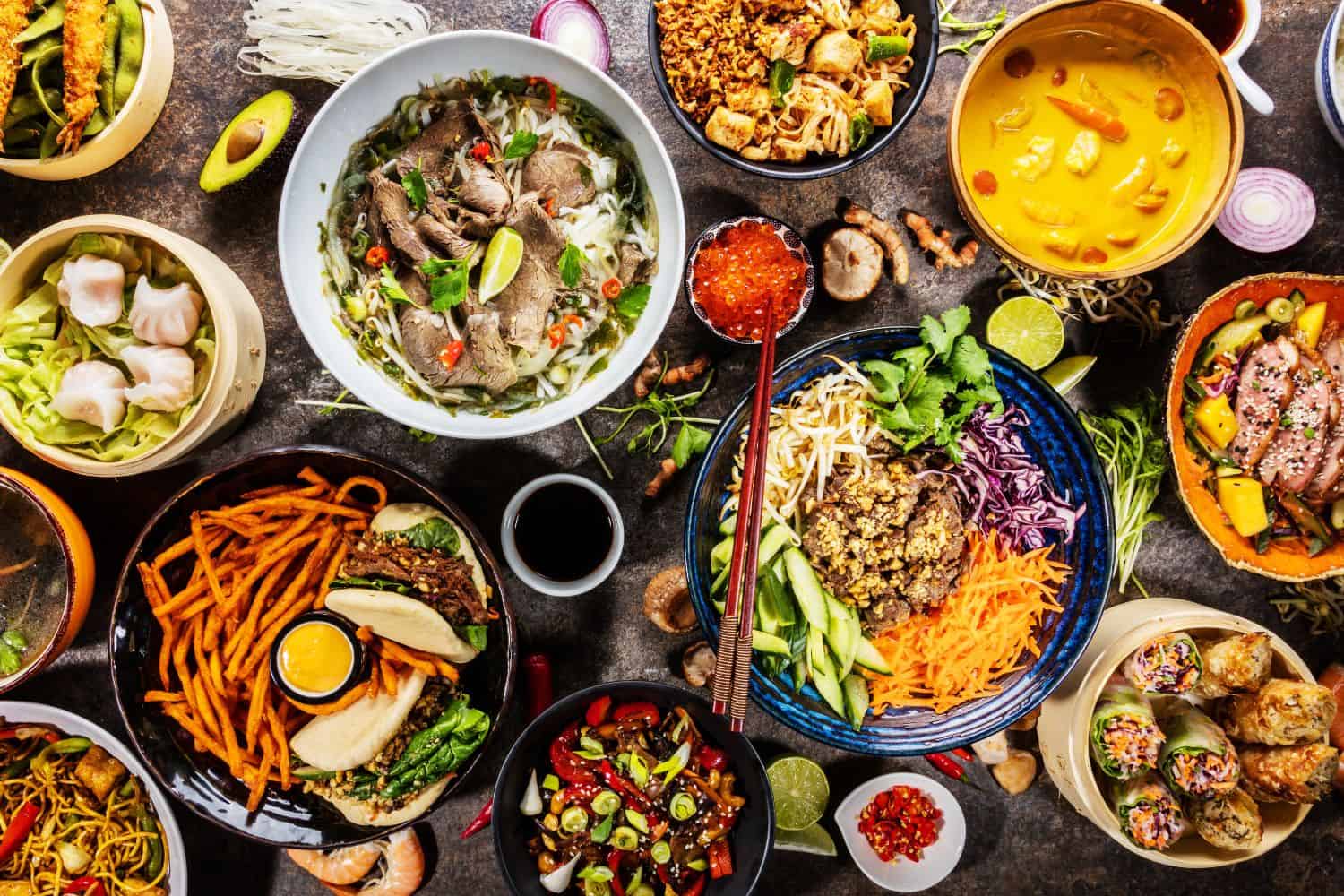Table of Contents
Explore Bhutan culture as we offer you a comprehensive understanding of Bhutan’s customs and its rich and colorful heritage, including traditions, values, and unique customs and practices.
Bhutanese people greatly value hospitality, warmly welcoming guests into their midst. Family plays a central role in Bhutanese society, fostering strong connections and a profound sense of community. It’s important to note that Bhutan culture is constantly evolving, shaped by historical events, regional dynamics, and global interactions.
Gaining insight into the culture of Bhutan can provide valuable perspectives on the intricate and diverse society of the nation.
Bhutan Culture
Here are the most important points to begin learning about Bhutan culture and customs:
- Ethnic Diversity: Bhutan is home to a diverse mix of ethnic groups, each with its own customs and traditions. The major ethnic communities include the Ngalops, Sharchops, and Lhotshampas.
- Languages: The official language of Bhutan is Dzongkha, but several regional languages and dialects are spoken throughout the country, including Sharchopkha and Nepali.
- Buddhist Practices: Bhutan is predominantly a Buddhist country, and Buddhism is deeply ingrained in Bhutan culture, influencing daily life, values, and societal norms. This includes meditation, prayer flags, and the importance of karma. The majority of Bhutanese practice Vajrayana Buddhism.
- Greeting Etiquette: Greetings hold significant importance in Bhutan culture. Traditional forms of greeting include the “Namaste” gesture with palms together, and it is common for people to bow slightly as a sign of respect.
- Traditional Clothing: Bhutanese traditional clothing, known as the “gho” for men and “kira” for women, is commonly worn. The style and colors of these garments vary by region and occasion but are a vital part of Bhutanese identity.
- Cuisine: Bhutanese cuisine features dishes like “ema datshi” (chili and cheese), “dzow” (rice), and various stews. It often incorporates unique ingredients like dried yak cheese and red rice.
- Hospitality: Bhutanese people are known for their warm hospitality. Guests are typically offered tea, meals, and a place to stay, and it is considered polite to accept such offers graciously.
- Respect for Elders: Respect for elders is deeply ingrained in Bhutan culture. Younger individuals show deference to their seniors through words and actions.
- Arts and Crafts: Bhutan has a rich tradition of arts and crafts, including intricate thangka painting, wood carving, and traditional Bhutanese architecture.
- Music and Dance: Traditional Bhutanese music includes instruments like the “drangyen” and “lugen.” Folk dances play a significant role in cultural celebrations and festivals.
- Celebration of Festivals: Bhutanese celebrate various religious and cultural festivals, such as Tshechu and Losar (New Year). These festivities often involve religious rituals, mask dances, and communal feasting.
- Family and Community: Family is central to Bhutanese society, and strong community bonds are essential for support and social cohesion.
- Gender Roles: Traditional gender roles exist, with distinct expectations for men and women. However, there is an increasing push for gender equality and women’s empowerment in Bhutan.
- Arranged Marriages: Arranged marriages are still common in Bhutan, with families playing a pivotal role in matchmaking. Marriages are seen as not only a union between individuals but also between families.
- Cultural Preservation: Bhutan places great importance on preserving its culture and traditions, which is reflected in policies such as “Gross National Happiness,” emphasizing cultural heritage.
These customs are essential aspects of Bhutan culture and are readily visible in everyday life, showcasing the country’s rich cultural heritage, spirituality, and emphasis on tradition and community.
Bhutan Traditional Attire
Bhutanese traditional attire reflects the country’s unique cultural heritage, regional distinctions, and historical influences. The clothing worn by Bhutanese individuals serves both functional and cultural purposes, showcasing the nation’s rich diversity.

1. Regional Variation: Bhutan’s traditional clothing varies across its regions, influenced by factors such as climate, lifestyle, and ethnic traditions. In the cooler northern areas and mountainous regions, people often don heavier and layered garments, while those in the warmer southern parts opt for lighter attire.
2. Bhutanese Gho and Kira: One of the most iconic traditional outfits in Bhutan is the “gho” for men and the “kira” for women. The gho is a knee-length robe tied at the waist with a belt, and the kira is an ankle-length dress. These garments are typically colorful and feature intricate patterns.
3. Ethnic Diversity: Bhutan is home to various ethnic groups, each with its distinctive traditional attire. For example, the Lhotshampas in the southern regions have their own clothing styles, characterized by vibrant colors and unique patterns.
4. Nomadic and Tribal Dress: Some nomadic and tribal communities in Bhutan, like the Brokpas, have clothing tailored to their traditional way of life. Their attire often includes fur-lined garments, distinct headgear, and intricate jewelry, all of which hold cultural significance.
5. Modesty and Cultural Significance: Bhutanese traditional clothing emphasizes modesty, with garments covering the body. The colors, fabrics, and embroidery chosen often carry cultural and regional meanings. Additionally, the attire may signify one’s social status and marital status.
6. Special Occasion Dress: Bhutanese individuals dress elaborately for special occasions, including weddings, festivals, and religious events. During such events, they adorn themselves with ornate clothing featuring intricate handwoven designs, beadwork, and jewelry.
7. Modern Influence: While traditional attire remains significant, Bhutan’s urbanization and exposure to modern influences have led to the integration of Western clothing in daily life, especially in cities like Thimphu. Many Bhutanese people now combine traditional and contemporary clothing, reflecting changing lifestyles and global fashion trends.
Bhutan’s traditional attire is not just a matter of clothing; it represents a vibrant expression of the country’s diverse culture, history, and identity. It serves as a visual testament to the rich tapestry of traditions that have shaped Bhutanese society for centuries.
Bhutan Marriage Traditions
Bhutanese marriage traditions are deeply rooted in the country’s unique cultural and religious heritage, with variations across different regions and ethnic groups. These traditions hold great significance in Bhutanese society, reflecting historical practices as well as contemporary influences.

1. Arranged Marriages: Arranged marriages are common in Bhutan. Families play a crucial role in selecting suitable partners for their children. These arranged marriages are considered a way to preserve cultural and social ties and ensure compatibility between families.
2. Matchmakers: Matchmakers, known as “sangay menlha” in Dzongkha, assist in finding compatible matches for individuals. They take into account factors like family background, social status, and compatibility when suggesting potential partners.
3. Engagement: Once a suitable match is found, the engagement process begins with a formal agreement between the families. This agreement, often referred to as “thrimshung” or “zhugdrel,” symbolizes the commitment of the couple to marry.
4. Wedding Celebrations: Bhutanese weddings are elaborate affairs that typically span several days. They involve traditional rituals, feasting, music, and dancing. The main wedding ceremony, known as “Chenrigzwai,” involves the exchange of vows and blessings and is usually held at a local temple or a sacred site.
5. Bride Price (Yebthung): The groom traditionally provides a “yebthung” or dowry to the bride’s family as a gesture of commitment and financial support. The specific details of this practice may vary among different regions and families.
6. Bridal Attire: Brides in Bhutan often wear elegant and intricately woven dresses, complemented by beautiful jewelry. The style of attire varies depending on the region and the ethnic group, with Bhutanese, Lhotshampa, and other groups having distinct styles.
7. Post-Wedding Customs: After the wedding, various traditions may continue, including a celebratory feast known as “Zhabtoen,” hosted by the groom’s family. The bride may also partake in rituals symbolizing her integration into her new household.
8. Spiritual Significance: Marriage in Bhutan is not only a social but also a spiritual union. It is often conducted in accordance with Buddhist customs and may involve prayers, blessings, and offerings at temples or monasteries.
9. Community Involvement: Bhutanese weddings are not just about the couple; they are communal celebrations. Extended families and the broader community play essential roles in supporting and participating in the festivities.
10. Modern Trends: In urban areas and among the younger generation, there is a growing trend towards love marriages, where individuals choose their life partners based on personal preferences. Even in such unions, many traditional customs and ceremonies are often retained.
Bhutanese marriage traditions reflect the importance of family, community, and cultural heritage in Bhutanese society. While some aspects have evolved over time, these traditions continue to play a significant role in preserving Bhutan’s rich cultural identity and fostering social bonds.
Bhutan Food Culture
Bhutanese food culture is a captivating blend of flavors and ingredients that reflect the country’s history, geography, and the influence of neighboring culinary traditions from Tibet, India, and China.

- Regional Variation: Bhutan’s diverse geography, from lush valleys to rugged mountainous terrain, has given rise to a variety of regional cuisines. Food from Bhutan incorporates local ingredients and cooking techniques, creating a rich tapestry of flavors.
- Staple Foods: Bhutanese cuisine relies on staple foods such as red rice, buckwheat, maize, and barley. Red rice, in particular, is a staple in many Bhutanese meals.
- Spices and Seasonings: Bhutanese cuisine is known for its use of spices like dried red and green chilies, garlic, ginger, and Sichuan pepper. These spices lend a unique and bold flavor to dishes.
- Ema Datshi: One of the most iconic Bhutanese dishes is “ema datshi,” a spicy chili and cheese stew. It is often considered the national dish and is enjoyed by locals and visitors alike.
- Momos: Bhutanese cuisine features dumplings called “momos,” filled with a variety of ingredients like beef, pork, or vegetables. They are often served with spicy dipping sauces.
- Suja and Ara: Suja is a traditional Bhutanese butter tea made with tea leaves, butter, and salt, while Ara is a locally brewed alcoholic beverage. Both are commonly consumed in Bhutan.
- Vegetarian Options: Bhutanese cuisine offers a wide range of vegetarian dishes, including “phaksha paa” (stir-fried pork with radishes), “shamu datshi” (mushrooms with cheese), and various vegetable curries.
- Social Dining: Bhutan culture emphasizes communal dining. Families and friends often gather around a low table called a “thokbu” to share meals, fostering a sense of togetherness.
- Preservation of Tradition: Despite modern influences, Bhutanese cuisine remains deeply rooted in tradition, with many households still following age-old recipes and cooking techniques.
- Modern Fusion: In urban areas, there is a growing trend of fusion cuisine, where Bhutanese chefs combine traditional recipes with international flavors, catering to evolving tastes.
Book our services
These guiding services ensure that your journey is not only enjoyable but also informative and hassle-free. Bhutan’s cultural delights, historical marvels, and natural wonders await your exploration with RJ Travel LLC. Our Bhutan Private Tours are designed to immerse you in the rich cultural heritage, historical significance, and breathtaking landscapes of this extraordinary nation.
Contact Us and our team will make sure to help you plan your trip to Bhutan when it’s safe and ready for travel. Whether you’re interested in joining a pre-arranged Bhutan small group tour or creating a custom itinerary, we are here to make your Bhutanese adventure an unforgettable reality.
More About Bhutan
[the-post-grid id=”50343″ title=”Bhutan Main page”]
Book Your Trip to Bhutan Today!
Embark on an unforgettable journey and explore the allure of Bhutan through our exclusive tours.
